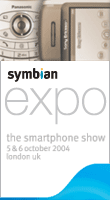 While the seminars offer the best "find out what's going" the Training Sessions give you the opportunity to get in-depth with the Symbian OS and certain areas. These sessions over 2 to 3 hours each, are led by the key developers, designers and coders in Symbian OS. The catch is that because of the depth in these courses, they're one of the few things that you (or your company's IT Budget)
While the seminars offer the best "find out what's going" the Training Sessions give you the opportunity to get in-depth with the Symbian OS and certain areas. These sessions over 2 to 3 hours each, are led by the key developers, designers and coders in Symbian OS. The catch is that because of the depth in these courses, they're one of the few things that you (or your company's IT Budget)
Enterprise Development with OPL
Led by Ewan Spence (now there's a familiar name - Rafe) this is a beginners course for everyone who wants to learn the Open Source scripting, BASIC like language. Starting from a clean PC, Ewan will install all the relevant tools, overlay the OPL plug ins, and take you through the basics of the language, program design and event based coding to let you walk out the Expo with a fully working units conversion application.
Symbian OS Kitbag
Aimed at the experienced C++ programmer, this is the "rosetta stone" course that should allow you to understand the intricacies of Symbian's C++ dialect. It's based around Codewarrior's IDE, so you should be familiar with that before you sit down in the course. It's geared around building programs, the development cycle, and has a mix of presentations and "follow me" example projects.
Java Kitbag
If C++ is the big powerful coding language, then Java was pitched as the cheap and cheerful alternative. The Java Kitbag session will introduce J2ME and MIDP to the Java programmer, walking you through suitable IDE's and tools, before going on to examine MIDP 2.0 and the new Symbian OS specific API's.
Active Objects
Active Objects are the building blocks of Symbian C++ coding, and a good understand of how they work is fundamental to good Symbian OS programming, especially when you need to do co-operative multi-tasking. From kernel up to application level, the active objects framework is explained and put to good use.
Client/Server
Client Server architectures in Symbian OS is probably one of the least understood, but most rewarding areas, of programming. After taking about the best way to implement these, this course will build up a typical server, the API calls required, the client communications, all with exercises in development throughout the course.
EKA1 and EKA2 compared
The EPOC Kernel Architecture for Symbian OS is what is at the root of everything. Changing over to EKA2 for Symbian OS 8.0 has introduced many changes to those used to working on EKA1. Obviously a good knowledge of EKA1 is needed and this seminar will look at the key components, layers, driver models and the key class changes.
Device drivers
Kernel side programming of device drivers - focusing on the logical / physical driver model, and what will happen to driver programming in Symbian OS 8.0 and the new kernel will be discussed, along with interrupt handling delayed function calling.
Drawing your UI's view
Having great code is all well and good, but the end user needs to be able to see what's going on. Symbian OS promotes the idea that the User Interface code should be separate from the program code - so if you switch an app from UIQ to S60 you only change the interface and nothing else. How well does this work in reality? How can you test just the program without the UI. Learn about the independence possible here.
MultiMedia Framework (MMF)
Audio and Video, MP3's, Real, MPEG... computing nowadays is all about what you can see and hear (in the minds of many). Symbian's Multimedia Framework opens up all these areas to the developer. Headsets, streaming, camera functions, and more are all here.
